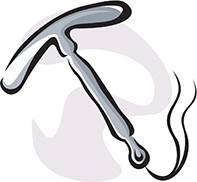How to insert and remove an IUD
The first modern intrauterine device (IUD) was developed by Richard Richter in 1909; however, the concept of intrauterine contraception is an ancient one. Arab camel traders reportedly placed smooth stones within the uterus of their female camels to prevent pregnancy during long journeys. Hippocrates also described the use of intrauterine contraception.
According to the last national survey, IUDs are used by 1.2% of women in Australia and remain a very useful contraceptive choice provided the patient has been well selected (see the box on page 46) and has been counselled adequately regarding the pros and cons of this method. Prior discussion also allows for sexually transmitted infection (STI) testing (e.g. for chlamydia and gonorrhoea) in women who are at higher risk. Cervical cytology is indicated if the woman is beyond the recommended cervical screening interval because it is difficult to spare the IUD strings if future treatment is required. Any irregular menstrual bleeding should be investigated before inserting the device. There is no indication for routine vaginal swab and culture before insertion of an IUD.

